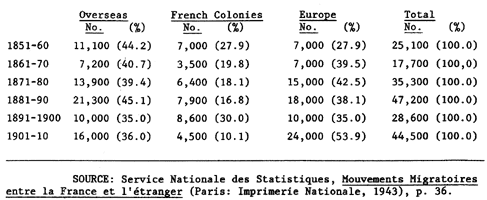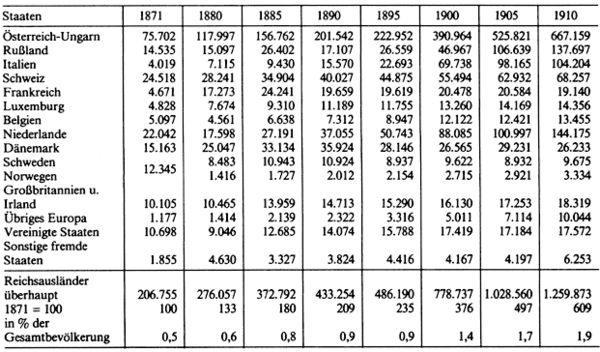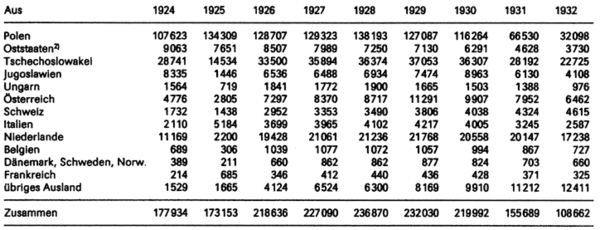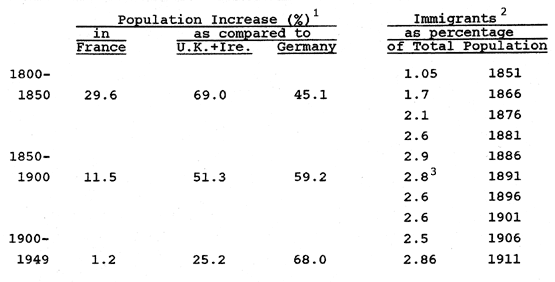- Diversité culturelle et territoriale en Europe de l'Ouest jusqu'à l'ère des révolutions
- Des "bouffeurs de grenouilles" méprisés aux "meilleurs" Allemands - L'histoire des Huguenots en Allemagne
- Introduction
- La France, terre d'exil 1830-1914
- Artisans allemands à Paris au XIXe siècle
- Migrants du travail italiens et polonais depuis les années 1870
- Appartenance ou exclusion: minorités, concitoyens juifs, nationalité
- Immigration en provenance des colonies françaises jusqu'en 1945
- Depuis la Seconde Guerre mondiale
- Sources et bibliographie
- Migration économique, exil politique et critique sociale: Les Allemands à Paris au XIXème siècle
- Minorités, immigrés et intégration en France
- Immigration et problèmes d'intégration en Allemagne depuis 1960
- Laïcité et religion dans la France contemporaine
- Comparaisons socio-culturelles
- 1968 et ses conséquences
- Rencontres au quotidien
Vous êtes ici: Deuframat > ... > Aperçu des migrations sur deux siècles > Tableaux des migrations
Tableaux des migrations
Tabelle 2: Total Numbers of French Abroad and Immigrants in France, 1851-1911
¹ Service National des Statistiques, Mouvements Migratoires entre la France et l'étranger (Paris: Imprimerie Nationale, 1943), pp. 34, 36 and 70.
² Georges Mauco, Les étrangers en France (Paris: Armand Colin, 1932), p. 38; cf. Service National des Statistiques, p. 70.
Tabelle 3: Annual Average of Emigrants and Immigrants, 1851 - 1911
Tabelle 4: Destinations of French Emigrants (annual averages)
NOTE: It may be noted that emigration to the French colonies did not increase considerably until the interwar period, when it accounted for 35.6 percent from 1921-1930 and 43.5 percent from 1931-35 of total French emigration. Service National des Statistiques, p. 39.
Tabelle 5: Ausländer im Deutschen Reich, 1871 bis 1910
Tabelle 6: Ausländische Arbeiter in Deutschland 1924-1932 nach Staatsangehörigkeit (nach Angaben der DAZ)¹
¹ Erfaßt wurden nur die ausländischen Arbeiter in jenen deutschen Ländern, in denen die DAZ mit der Ausstellung der Legitimierungskarten bzw. ab 1923 der Befreiungsscheine beauftragt war (vor allem Preußen, beide Mecklenburg, Thüringen u.a.m.). Nicht oder nur unvollständig erfaßt wurden die ausländischen Arbeiter, die beschäftigt waren in Bayern, Sachsen, Württemberg, Baden, Oldenburg und Hamburg.
² Hierunter wurden erfaßt die Sowjetunion (Rußland und die Ukraine), Lettland, Estland, Litauen und Finnland.
Tabelle 7: Ausländische Arbeitskräfte in Deutschland 1936-1938 (nach Staatsangehörigkeit
Tabelle 8: French Population Growth and Immigration
¹ Hilde Wander, The Importance of Emigration for the Solution of Population Problems in Western Europe (The Hague: Martinus Nijhoff, 1951), p. 51. Compare George Mauco's figures of French population growth by 20-year periods, which are less dramatic but nonetheless telling of constant declining growth: 1801-21: 4.9%; 1821-41: 5.6%; 1841-61: 3.4%; 1861-81: 2.7%; 1881-1901: 1.8%. Les étrangers en France (Paris: Armand Colin, 1932), p. 18.
² Mauco, Les etrangers en France, p. 38.
³ See Figure 6.1 for statistical effects of the 1889 nationality law.






